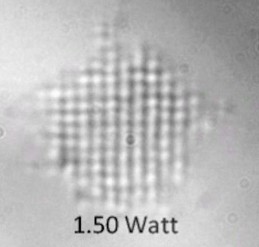Lasers used to form 3-D crystals made of nanoparticles
June 1, 2011

Microscopic images of optically induced crystals forming (credit: Georg Raithel, University of Michigan)
Physicists at the University of Michigan have used the electric fields generated by intersecting laser beams to trap and manipulate thousands of microscopic plastic spheres, thereby creating 3-D arrays of optically induced crystals.
The process involves shining laser beams through two opposed microscope lenses, one directly beneath the other. Two infrared laser beams are directed through each lens, and they meet at a common focal point on a microscope slide that holds thousands of plastic nanoparticles suspended in a drop of water.
The intersecting laser beams create electric fields that vary in strength in a regular pattern that forms a 3-D optical lattice. The nanoparticles get sucked into regions of high electric-field strength, and thousands of them align to form optically induced crystals. The crystals are spherical in shape and about 5 microns in diameter.
The technique could someday be used to analyze the structure of materials of biological interest, including bacteria, viruses, and proteins, the researchers said.
Ref.: B. Slama-Eliau, G. Raithel, Three-dimensional arrays of submicron particles generated by a four-beam optical lattice, Physical Review E, 2011; 83 (5) [DOI: 10.1103/PhysRevE.83.051406]